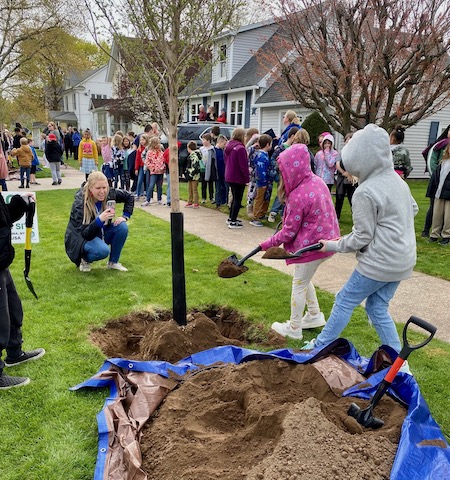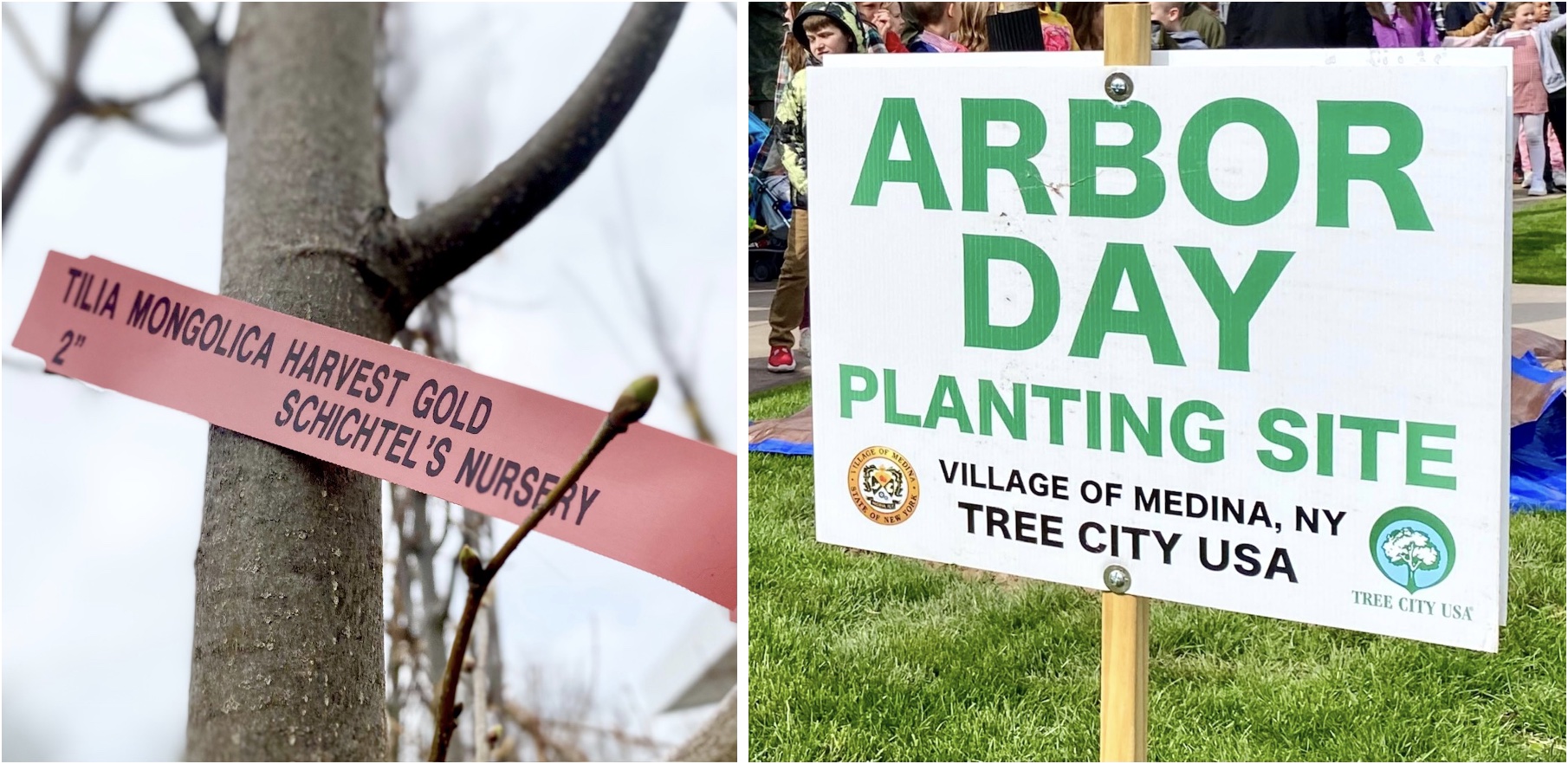Medina will plant nearly 70 trees for Arbor Day on Friday
Press Release, Village of Medina Municipal Tree Board

Provided photos: Students from Oak Orchard School in Medina celebrate Arbor Day Medina in 2023. The students will again help plant Arbor Day trees on Friday.
MEDINA – April in the Village of Medina means it will soon be Arbor Day and once again, Medina will be celebrating in a big way.
Arbor Day, observed nationally on the last Friday of April, falls on April 26 this year.
“Sixty-nine trees in all will be planted this year,” said Chris Busch, Medina’s Forestry Coordinator. “Forty-four trees will be planted on North Avenue, South Avenue, West Avenue, Park Avenue and State St. Park, with 25 hardwood seedlings going in Boxwood Cemetery.”
Medina’s observance will be held on the east end, south side of North Avenue at West Avenue in the village (kitty-corner from Lee-Whedon Memorial Library). The east end of North Avenue will be briefly closed for the occasion.
Barring a rainy day, this year’s celebration will start at 10 a.m. and include the reading of the Arbor Day Proclamation by Mayor Marguerite Sherman, and enthusiastic participation by the 2nd and 3rd graders from Medina Central School. The Oak Orchard Glee Club will also be performing on stage.
“We’d like to give a huge ‘thank you’ to Superintendent Mark Kruzynski for Medina CSD’s continued participation in our annual Arbor Day Celebration and for providing Mrs. Andrea Busch as a school-based resource,” said Mary Lewis, Tree Board chairwoman. “We’re so grateful! The schools have been a colossal part of Medina’s Arbor Day tradition for over fifteen years!”
The Tree Board’s focus has been a three-pronged approach for several years: Main arteries and Central Business District area, parks, and high-need residential areas.
“The need for plantings in all of these areas continues,” said Mary Lewis, Medina’s Tree Board Chair. “Plantings from previous years are maturing and are making a real visual impact in the streetscape. The new trees we’ve been planting in our parks are truly improving those areas, and we’re beginning to make headway on our neighborhoods. There’s still so much to be done and I wish we could do more.”
Volumes of research on the impact of street trees show numerous benefits, including increase property values, slower/ safer traffic patterns, lower urban air temperatures, and absorption of harmful pollution. Recent research also indicates tree-lined streets in neighborhoods result in – among other things – lower blood pressure and improvement to overall emotional and psychological health.
“Tree-lined streets really do have an incredibly huge impact on many levels,” Lewis said. “There are many legitimate studies that bear this out. The benefits from investing in street trees are many and tangible. We hear this constantly from citizens throughout the year about how much they appreciate the beauty of our tree-lined streets. It’s very gratifying.”
Arbor Day 2024 will mark the 17th year Medina’s urban forestry program has been a participant in the Tree City USA program of the National Arbor Day Foundation. The annual Tree City award honors Medina’s commitment to community forestry.
The Tree City USA Program is sponsored by the Arbor Day Foundation in cooperation with the National Association of State Foresters, and the USDA Forest Service. Tree City USA is awarded annually to those communities who qualify and is a national designation.
Medina’s Municipal Tree Ordinance and Arbor Day Celebration have been a model for several other communities looking to establish a board and planting program. Medina receives many inquiries for assistance and advice every year from municipalities across the state.
“In recent years, approximately 40 to 50 trees are inspected and recommended for removal. Each year we replace approximately the same number of trees in the community,” Busch said. “We’re keeping pace, but there is much more work to be done throughout the village.”
Busch continued, “We owe an enormous debt of gratitude to Jason Watts, DPW Superintendent and his expert tree crew. They do it all with a high degree of professionalism and care– plant, prune, maintain and remove. They genuinely care about our village trees and we’re incredibly lucky to have them.”
The village maintains a policy of diversity in its urban forest plantings. Species to be planted this year include Honey Locust, Zelkova, Katsura, Crab apple, American Hornbeam, Serviceberry, and varieties of Maple.

(Left) Tilia mongolica “Harvest Gold” linden is of the many varieties being planted in Medina this Arbor Day. 40’ x 30’ at maturity, this tree’s name is inspired by a mantle of bright golden yellow leaves in autumn. (Right) The familiar Arbor Day signs in Medina mark the sites where the celebration will be observed.
Boxwood Cemetery trees will employ an entirely different focus and method of planting.
“Boxwood Cemetery is 175 years old and presents several difficult challenges for maintaining, removing and planting trees,” said Busch. “The old section on the hill in particular is a challenge on many levels. Most of the trees are very old. They were planted when the cemetery was new and space was still available. Now, those trees are at the end of their lives, are quite large, and are situated among numerous old graves and monuments. Their removal requires a great deal of care and specialized skill.”
“Many trees have been removed with more on the list to go, so we had to devise a workable, minimally intrusive plan to install trees for erosion control and soil stability,” said Busch. “After much research and deliberation, we’ve decided to utilize hardwood seedlings and grow tubes. This will allow us to reforest these difficult sections in a way that will result in an appropriate tree placed exactly where we want it in a minimally invasive manner. And, it’s relatively inexpensive by comparison.”
Busch explains the seedlings to be used were sourced from a hardwood nursery in Wisconsin and reflect many of the original species used in the historic cemetery. Further, the grow tubes will not only protect the trees from harsh conditions and deer browse, but will also greatly accelerate the growth, up to 4-5x.
Species include Shagbark hickory, Sugar maple, Red oak, and White oak, all species currently in the historic landmark cemetery.
“For this application, we believe it’s a good solution.”
Mary Lewis emphasized that while the village makes great progress each year, there is still much more work to be done throughout the village and Boxwood. With increasing costs and limited funding, the task is daunting, but they’ll rise to meet the challenge.
“Municipal budgets are tight and getting tighter. The cost of trees from growers has seen double-digit percentage increases in the last nine years and that’s a huge challenge,” said Lewis. “Each year we remove 40+ trees that are dead, dying and hazardous. The good news is we replace those trees with new, more beneficial and desirable cultivars. It’s an investment worth making.”
Busch states that the science of street trees and urban forestry has progressed and developed tremendously in the last 40 years with a greater understanding of new cultivars developed specifically for urban use.
“At the turn of the nineteenth century when most of our village forest was planted, there was little choice for a street tree– elms and oaks were the more expensive option, and Silver maple was the cheaper option,” Busch explained. Municipalities were interested in large, fast-growing trees that created beautiful tree-lined streets. They had little knowledge of any unintended consequences and infrastructure was different.”
Busch further explained that despite looking very nice, those trees caused big problems.
“One hundred years later, these Silver maples are massive at nearly 70-plus feet and create numerous issues with infrastructure, safety and utilities. Today, thanks to extensive research and purpose-driven breeding, there are literally hundreds of cultivars in every shape and size for use in a variety of urban conditions. We take into consideration the limitations and conditions on every site, and select the right tree for the right spot. This insures a much healthier and desirable village forest.”
Lewis states, “Thankfully, the village has been consistently supportive of our efforts to reforest the village utilizing new urban forestry knowledge, and we’re grateful for it. Additional critical funds have come from an extremely generous community in donating money for trees, both as memorials and general plantings. People in Medina have really embraced our efforts and see the importance of trees in the village. They truly enjoy the aesthetic impact they have on our streets and neighborhoods.”
Lewis went on, “We’re incredibly grateful for the on-going financial support we receive through ReLeaf Medina. Without the generosity of the community, citizens and businesses, we wouldn’t be able to do it. It really does take an entire community to accomplish what we do.”
According to Lewis, tax-deductible donations can be made anytime for general tree planting, memorial trees or for “trees on your street”. Additional information can be obtained at the Village Clerk’s Office or by downloading the ReLeaf brochure online at villagemedina.org, or by contacting Lewis at mlewis.villagemedina@gmail.com.
“Financial support in the form of gifts and donations from the public and businesses are critical,” said Lewis. “We’re so appreciative of the support which is vital for the future. We encourage citizens to continue their support and urge corporations to consider becoming an annual corporate sponsor. Our tree-lined streets are definitely a contributing factor in people’s decision to locate their family or business in Medina and their donations play a huge role in making our efforts possible.”







































































